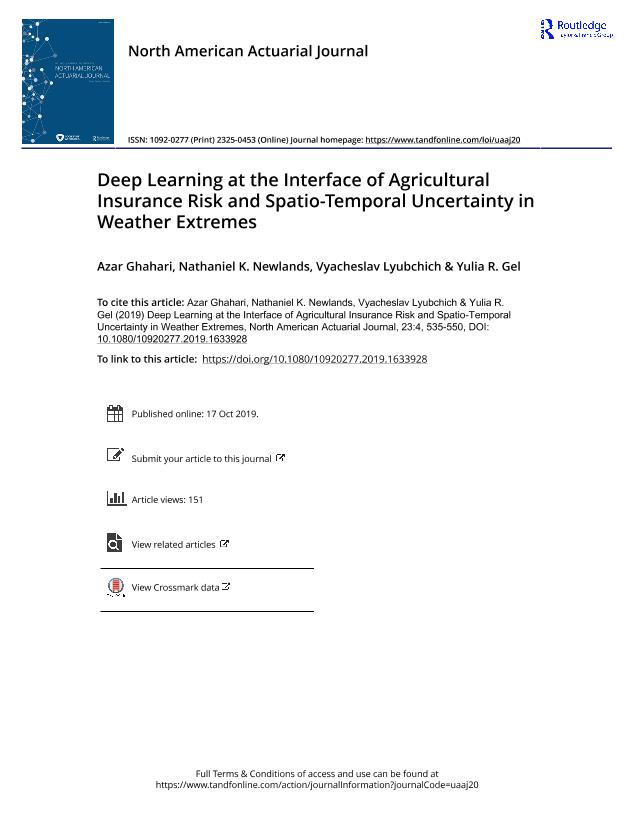Deep learning at the interface of agricultural insurance risk and spatio-temporal uncertainty in weather extremes

Contenido multimedia no disponible por derechos de autor o por acceso restringido. Contacte con la institución para más información.
| Tag | 1 | 2 | Valor |
|---|---|---|---|
| LDR | 00000cab a2200000 4500 | ||
| 001 | MAP20200004868 | ||
| 003 | MAP | ||
| 005 | 20200221135947.0 | ||
| 008 | 200217e20191202usa|||p |0|||b|eng d | ||
| 040 | $aMAP$beng$dMAP | ||
| 084 | $a329 | ||
| 100 | 1 | $0MAPA20200003434$aGhahari, Azar | |
| 245 | 1 | 0 | $aDeep learning at the interface of agricultural insurance risk and spatio-temporal uncertainty in weather extremes$cAzar Ghahari [et at.] |
| 520 | $aChallenges in risk estimation for agricultural insurance bring to the fore statistical problems of modeling complex weather and climate dynamics, analyzing massive multi-resolution, multi-source data. Nonstationary space-time structure of such data also introduces greater complexity when assessing the highly nonlinear relationship between weather events and crop yields. In this setting, conventional parametric statistical and actuarial models may no longer be appropriate. In turn, modern machine learning and artificial intelligence procedures, which allow fast and automatic learning of hidden dependencies and structures, offer multiple operational benefits and now prove to deliver a highly competitive performance in a variety of applications, from credit card fraud detection to the next best product offer and customer segmentation. Yet their potential in actuarial sciences, and particularly agricultural insurance, remains largely untapped. In this project, we introduce a modern deep learning methodology into the assessment of climate-induced risks in agriculture and evaluate its potential to deliver a higher predictive accuracy, speed, and scalability. We present a pilot study of deep learning algorithmsspecifically, deep belief networksusing historical crop yields, weather stationbased records, and gridded weather reanalysis data for Manitoba, Canada from 1996 to 2011. Our findings show that deep learning can attain higher prediction accuracy, based on benchmarking its performance against more conventional approaches, especially in multiscale, heterogeneous data environments of agricultural risk management. | ||
| 650 | 4 | $0MAPA20080578213$aSeguros agrarios | |
| 650 | 4 | $0MAPA20080601522$aEvaluación de riesgos | |
| 650 | 4 | $0MAPA20080630010$aCondiciones climáticas ambientales | |
| 650 | 4 | $0MAPA20080600273$aClimatología agrícola | |
| 650 | 4 | $0MAPA20080575328$aCultivo agrícola | |
| 650 | 4 | $0MAPA20080560447$aRendimiento | |
| 650 | 4 | $0MAPA20080586546$aNuevas tecnologías | |
| 650 | 4 | $0MAPA20080553128$aAlgoritmos | |
| 650 | 4 | $0MAPA20080579258$aCálculo actuarial | |
| 651 | 1 | $0MAPA20080638337$aEstados Unidos | |
| 773 | 0 | $wMAP20077000239$tNorth American actuarial journal$dSchaumburg : Society of Actuaries, 1997-$x1092-0277$g02/12/2019 Tomo 23 Número 4 - 2019 , p. 535- 550 |

